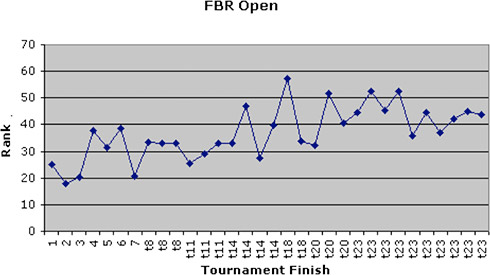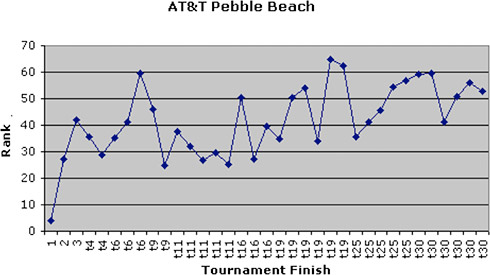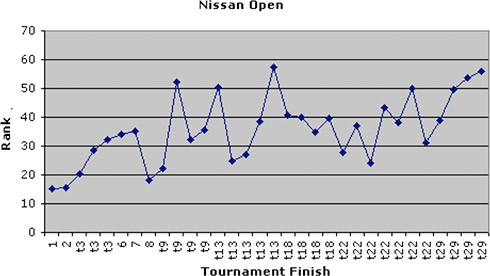 I am still somewhat new around here, but I know good numbers when I see them. No I’m not talking about how dominating Tiger Woods is in Official World Golf Ranking points or how Charles Howell III is leading the way in the FedEx Cup.
I am still somewhat new around here, but I know good numbers when I see them. No I’m not talking about how dominating Tiger Woods is in Official World Golf Ranking points or how Charles Howell III is leading the way in the FedEx Cup.
No, I’m talking about Dave Koster’s 40-30-20-10 Rule.
This week, we’ll apply Dave’s formula to the last three weeks’ results on the PGA Tour. Just how accurately does The 40-30-20-10 Rule correlate to tournament finishes? Then we’ll have a look at why this formula is so effective (assuming that it is…) and suggest some possible tweaks.
Prerequisite
Before I dive into the numbers let me first start by saying that I only took the top thirty from each of the three events. Obviously one could take the entire field, I just don’t have enough time to do such a thing at this point.
Once I had the top thirty from each tournament, I went through and grabbed their statistics from The Golf Channel’s excellent website (which breaks out the tournament-by-tournament stats while PGATour.com doesn’t!).
Once I had all of those numbers in a spreadsheet, I was able to calculate each player’s 40-30-20-10 ranking.
FBR Open
Most of you already know that Aaron Baddeley won this tournament by playing incredible golf, shooting rounds of 65-70-64-64. Not only did his scores show up well, he did really well in the putting stats. For the tournament Aaron averaged 26 putts per round. I can’t remember the last time I had less than 30 putts in one round!!
Now take in the graph below. As you can tell, Dave’s formula has done another outstanding job of ‘predicting’ the finish based on how well they fared in each of the statistical categories. I will get to prediction vs. results in a minute.

At a closer look at the one real anomaly in the graph we find Fred Funk. Fred finished the tournament in a tie for eighteenth. This really isn’t that big of a surprise to me at least because he really didn’t putt all that well. When you hit as many greens in regulation as he did (ranked 44th) and putt as poorly as he did (63rd), those strokes will sneak up on you rather quickly.
AT&T Pebble Beach National Pro-Am
Next we saw the pros play at hallowed Pebble Beach (along with Spyglass and Poppy Hills). This is the event where Mickelson looked to be back in control of his mental state for the first time since the disaster at Winged Foot. Philly Mick shot rounds of 65-67-70-66 to win by five strokes over Kevin Sutherland.
This is exactly what I would picture this graph to look like just by the little paragraph above. Dave’s formula is again just about right on the money.

The only real anomaly in this bunch would be a tie for sixth finisher, Corey Pavin. I’m really not sure how to explain this one other than Corey really didn’t do exceptionally well in either of the putting categories.
Nissan Open
The week leading up to Tiger’s mental lapse at the WGC Match Play event had us over at Riviera for the Nissan Open. This event saw one of the young guns on tour come through with a win by shooting rounds of 69-65-69-65. This young gun is Charles Howell III.
It did take a playoff for Mr. Howell to win for the first time in 2007, but he did so in what I am calling the perfect blend of statistics. Let’s let the graph speak for itself on this one.

So Why is it so Effective?
What this really all comes down to is where players are able to score the most. That is undisputedly on the greens. If a player is lighting it up on the greens, more often than not that player will be near the top of the leaderboard.
There can be exceptions to that, of course. For example, when a player is spraying them so badly off the tee they are taking out of bounds penalties on every hole, their stats will be a little skewed. But that doesn’t happen frequently on the PGA Tour, and isn’t really worth worrying about.
All in all, however, I find Dave has done a masterful job at creating this formula, and I hope I can only learn more from it as each column passes.
Predicting Tournament Outcomes Using the 40-30-20-10 Rule
Now this really is where you put the money where your mouth is. My goal for my next article is to publish a prediction for the following tournament based on a slightly modified 40-30-20-10 Rule. What I hope to accomplish out of this is to create a mathematical formula that can out predict The Golf Channel’s WinZone before a tournament starts. As my last article on the WinZone states, The Golf Channel claims their WinZone formula predicts the winner of the tournament after the first round 18% of the time. We will see if Mr. Koster’s formula can exceed those seemingly low expectations…
This article was written by guest author Harry Solomon, an active member of our forum.

David,
The Golf Channel’s Winzone looks to me like little more than a marketing tool. I saw the other day they were offering predictions on the outcome after the first round of play. That’s just silly, there’s not enough data to work with. Are you saying you want to beat their 18% rate at predicting outcomes prior to the start of a tournament? ?? Why not just use the money list, or Fedex cup points?
It’s just not possible to make meaningful guesses based on statistics when there are so many variables involved. It’s a little like predicting the weather, it really can’t be done.
Now, getting off the topic of predictions, the 40-30-20-10 rule is an interesting tool for investigating the relative importance of the various elements of golf. In my opinion, though, it’s too broad. You must account, somehow, for the player himself. That is, given a fellow who can average 300 yards, what’s the most important factor for him to score? Compare him to the 270 yard guy. In fact, compare Daly to Furyk. Furyk is obviously more successful in scoring, even though he averages 39 yards less off the tee (this year). Is it because Furyk hits 80% fairways, and Daly only 44%? We know Daly has a good short game, but is that cancelled out due to playing from the rough all the time?
The problem with statistical analysis of complex systems is that the elements which cause change interact to a degree which cannot effectively be accounted for.
If you want to prove me wrong, have at it. But, we’ll need to see your data, and we’ll need to see better correlation of the data in your graphs than those you have shown. Those data lines don’t seem to fit real well. Koster provided his raw data in spreadsheet form, perhaps you could as well. (His formulas had some issues, I’d like to see yours.)
This is an interesting article and it’s easy to do this after a tournament. The “Win Zone” did take a different approach to determining the winner by including multiple variables.
I agree with Will in that the “Win Zone” is a marketing tool and the complexity of the game…not to mention the inability to calculate human variability…can not be done. If it could why would anyone watch a tournament on TV?
I’m a data guy here @ work, but I’m not going to ask for your formulas or your raw data. The idea that the better you putt in a tournament places you higher on the leader board is nothing new in golf.
Regards,
TW
I have been saying the same thing as Will and Tyler. I just don’t see the amazement in the 40-30-20-10 rule. I think the formula is somewhat self-fulfilling.
Of course the winner or top players in a tournament must be putting well and hitting greens. Unless you have a huge distance advantage (such as driving Par 4’s) or a significant short game advantage (getting up and down from sand every time), these 2 factors are most important in determining the winner each week. Wow, what a revelation.
It would be interesting in quantifying approach shots on a 1 to 10 scale rather than on the green or not. They could do the same on drives rather than in the fairway or not. The same for short game shots and putting.
I do not think distance is everything, but it appears to be one area that really separates the better players from the “field”. If you look at many of the better players (Vijay, Tiger, Phil, Ernie), they can all drive the ball far, but they also have the short game to get themselves out of trouble. For the most part, their respective wedge play is usually excellent, but in general, their mid-iron play is usually not so excellent.
Predicting a winner from general golf stats is a crapshoot. The golf course usually favors certain players or golf games. There’s a good reason why Tiger does not play every week.
That’s like saying e=mc^2 is self-fulfilling. What if the rule was 10-20-30-40? Guess what? You wouldn’t get good results. Why? Because driving distance and accuracy have little to do with winning a tournament. Duh. That’s what this formula shows – what factors relate and how they’re weighted in placing well in PGA Tour events.
It’s not “self-fulfilling.” It’s accurate. And it’s really not intended to be used on a per-tournament basis, but over the course of a year. The 40-30-20-10 Rule is not a predictive tool – it’s an analytical tool. David’s attempting to fit it into a “predictive” mode, but I don’t agree with that use, and I don’t think the original author does either.
Except that it doesn’t, and Dave (Koster) has shown this – statistically – more than a few times. Look at how much closer to the hole bombers hit the ball, on average, than accurate drivers. It’s about 0.4 inches if I recall correctly. Sure, in his analysis and this formula, it’s 2x as important as driving accuracy, but it’s also half as important as the “40” stat and “2/7” as important as GIR/putting combined.
The point is this: great athletes in any sport often possess a great amount of speed. It’s no different in golf, except speed == driving distance. Big deal. I have no doubt that Tiger Woods would be 99% as effective as he is now if you took 20 yards off his average tee ball – he’s good where it actually counts: hitting greens and making putts.
Because he wouldn’t be able to perform at a high level, because he values his free time, because he’s not required to, and because his wife is a Swedish model?
I really didn’t “develop” the 40-30-20-10 rule. That would imply that I somehow forced it to work. That I forced it to be “self-fulfilling”. I ran and re-ran different percentages using data from numerous tournaments. Not just one here and there. 40-30-20-10 fit better than any other combination I could find.
You could say that 40-30-20-10 rule was created on its own. Will brings up interesting points about complex systems and there are a lot of statistics in golf…but the rule accounts for most shots in golf. Off the tee, into the green and on the green. I wanted to cover these basic areas and find how these interacted with each other.
Given that, to answer your question Will, I’m betting that Furyk ranks higher than Daly, on average, in GIR and Putting. Sure he might be shorter, and Daly more wild off the tee…but you can better analyze “the player” by using all the data from all players to see what works best.
Well, we don’t have that luxury, do we Andy. Nobody is ranking approach shots from 1 to 10. That might be a bit too subjective. All we have to work with, statistically, is what the PGA Tour or The Golf Channel provides. Proximity is as good as it gets…and, as Erik said, I’ve already correlated that with driving distance.
I’m hearing a lot of comments and quesitoning of the 40-30-20-10 rule…and I like it. It’s good to question anything. I’d rather hear this than a bunch of nodding heads and “uh-huh’s.”
What I have yet to see is someone suggest something better and back it up with hard data. The formula is simple. If adding something to it or changing it makes it better, I really would love to hear it. It’s not like I’m in this for money or anything…I just wanted to see what aspects of golf drove results (winnings) the most – and in what percentage.
Predicting using the rule is difficult because one course may favor the putter or the more accurate player. You really need to use the entire length of the year to truly anazlye the tour…and game of golf.
Now I’ll shut up…It’s late and I feel like I’m rambling.